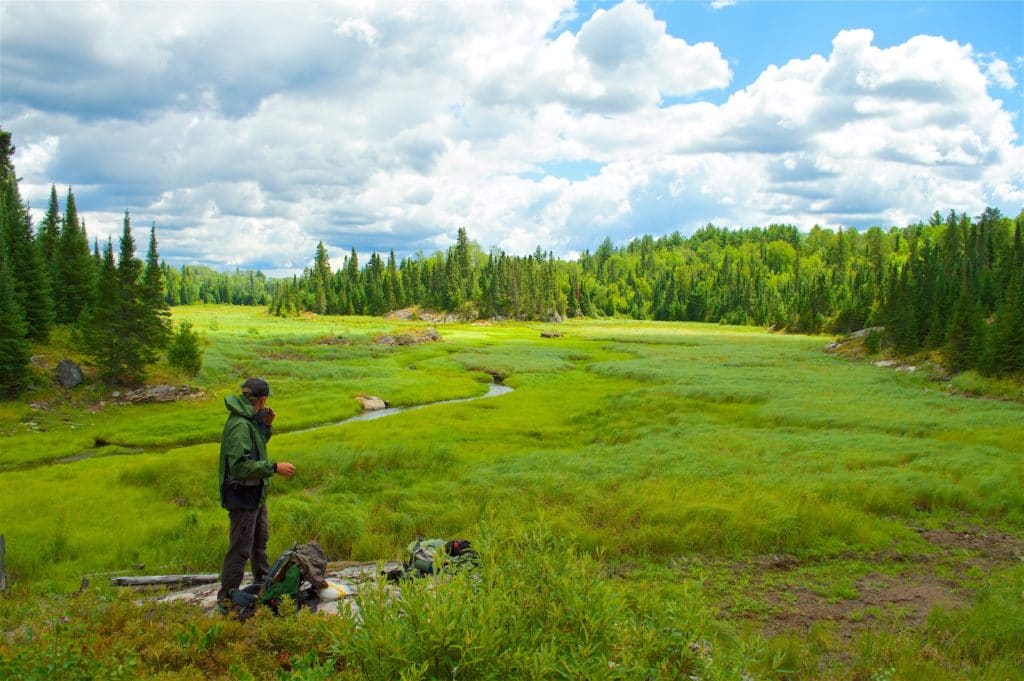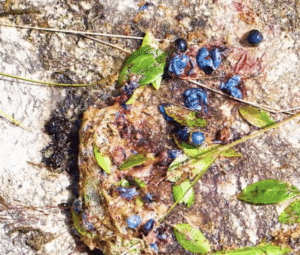
On the first day of August in 2017, wolf researcher Austin Homkes hiked into a former beaver pond just outside Voyageurs National Park. He was conducting a routine investigation of a location where a GPS collar on a wolf indicated a possible kill site, but Homkes saw something much different. In the open meadow, five wolf pups met up with an adult. The pups licked the adult’s mouth for about 30 seconds, and then the wolf regurgitated food for the young, who quickly ate it up. While wolves are known to feed their young by regurgitating prey, Homkes found this case was different when the wolves left and he went over to examine the site.

Remnants of the regurgitated meal were entirely blueberries. Biologists had never before observed wolves, which are primarily predators, providing berries in this way. In a scientific paper published yesterday in the Wildlife Society Bulletin, Homkes and his co-researchers describe the discovery as a significant step in understanding wolf diets in the Great Voyageurs Ecosystem.
“Though wild berries do not provide as much caloric value as mammalian meat, and are likely less digestible for wolves than mammalian meat, their abundance and relatively low risk and energetic cost to obtain likely makes berries a valuable alternate food source for wolves,” they wrote.
Wolf pups have been known to eat a lot of berries, but it was thought they probably foraged them around the pack’s rendezvous site, where the pups spend most of their time after leaving the den at eight weeks old.
Homkes is a field biologist for Voyageurs National Park and a graduate student from Northern Michigan University, working full-time on the Voyageurs Wolf Project. The collaborative project is led by University of Minnesota doctoral student Thomas Gable, and staffed by associate professor Joseph Bump of the U of M, and Steve Windels of the National Park Service. The work is funded by Minnesota lottery ticket sales through the Environment and Natural Resources Trust Fund, and other sources.
Foraging on film
The research team also shared video footage they captured last summer of wolves actually eating blueberries, a behavior never before believed to be filmed.
They say there are a few other video clips of wolves eating other berries, but not blueberries. The video was recorded by setting up cameras at remote locations. It took the team two years of trying to get the footage.
In recent years, the team has done extensive groundwork in and around Voyageurs National Park, revealing surprising secrets about wolves. Visiting every site where a collared wolf spends 20 minutes or more, Their primary goal is understanding wolf ecology in the summertime, while most study in the region has focused on the winter, when it is easier to track and observe wolves, and their diets consist of more whitetail deer and moose.
The importance of beavers and berries during the snow-free seasons has been a key finding.
Seasonal diet differences
The researchers have found that once summer is in full swing in the north woods, catching deer becomes far more difficult because fawns are faster, so the wolves turn to alternative food sources. Beavers too are harder to prey on in summer, when the aquatic rodents spend much of their time eating in the water, not on land where wolves are known to hunt them.
So they eat berries. Tracking data over the past few years has shown wolves spend great amounts of time grazing in blueberry patches, and analysis of their scat has indicated the fruit can make up to 83 percent of their diets in July and August.

Berries, primarily blueberries and raspberries, make up as much as two-thirds of the food eaten by adult wolves and more than 30 percent of the diet of pups in late summer.
“We think this unique observation, in combination with previous research in the [Greater Voyageurs Ecosystem], provides another example of the potential importance of berries as a food source for wolves,” the researchers wrote. They also say it could point to important ways in which wolves and humans can interact. For example, if the berry diet of wolves is so important to the survival and growth of their young, clear-cut logging on ridges could promote more berry growth, and thus a logged area could support a larger wolf population.
“Given the dearth of information on the role of berries in wolf ecology, we think considerable research is needed to understand the importance of wild berries to wolves,” they write.
As the study continues, researchers will keep studying these behaviors, and perhaps uncover more fascinating questions.
Reference and more information:
- Homkes, A.T., Gable, T.D., Windels, S.K. and Bump, J.K. (2020), Berry Important? Wolf Provisions Pups with Berries in Northern Minnesota. Wildl. Soc. Bull.. doi:10.1002/wsb.1065
- Voyageurs Wolf Project

